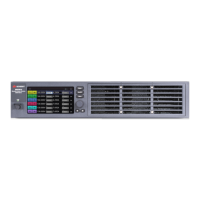Step 2. As shown in the diagram, use the differential probes to connect the differential amplifier to the
+ and - output terminals. Connect the shields of the two probes together. Connect the output of the
differential amplifier to the oscilloscope with an external 50 Ω termination at the input of the
oscilloscope.
Step 3. Set the probe to 1:1 and set the inputs of the differential amplifier to match the probe setting.
Set the inputs to ac coupling. Set the input resistance to 1 MΩ. Set the oscilloscope’s time base to 5
ms/div, and set the vertical scale to the maximum sensitivity without clipping the waveform. Turn the
bandwidth limit on (usually 20 MHz), and set the sampling mode to peak detect.
Step 4. Turn on the unit under test and program the instrument settings as described in the in the test
record form under “CV Ripple and Noise”. Turn the output on. Let the oscilloscope run for a few
seconds to generate enough measurement points. On the Keysight Infiniium scope, the maximum
peak-to-peak voltage measurement is indicated at the bottom of the screen on the right side. The
result should not exceed the peak-to-peak limits in the test record form under “CV Ripple and Noise,
peak-to-peak”.
If the measurement contains any question marks, clear the measurement and try
again. This means that some of the scope data received was questionable.
Step 5. Disconnect the oscilloscope and connect an rms voltmeter in its place. Do not disconnect the
50 ohm termination. Divide the reading of the rms voltmeter according to the differential amplifier
setting. The result should not exceed the rms limits in the test record form for the appropriate model
under “CV Ripple and Noise, rms”.
Current Programming and Readback Accuracy
This test verifies that the current programming and measurement functions are within specifications.
Step 1. Turn off the unit under test. Connect the current shunt directly across the output terminals.
Connect the DMM directly across the current shunt (see Test Setup C).
Step 2. Turn on the unit under test and program the instrument settings as described in the test record
form under “Current Programming & Readback Min”. Turn the output on. The output status should be
“CC”, with the output voltage close to zero. Wait 5 minutes for the temperature to settle.
Step 3. Divide the voltage drop (DMM reading) across the current shunt by the shunt resistance to
convert to amps and record this value (Iout). Also, record the current measured by the instrument over
the interface. The readings should be within the limits specified in the test record form under “Current
Programming & Readback, Minimum Current (Iout)”.
Step 4. Program the instrument settings as described in the test record form under “Current
Programming & Readback, High”. Wait 5 minutes for the temperature to settle.
Step 5. Divide the voltage drop (DMM reading) across the current shunt by the shunt resistance to
convert to amps and record this value (Iout). Also, record the current reading measured by the
instrument over the interface. The readings should be within the limits specified in the test record form
under “Current Programming & Readback, High Current (Iout)”.
Keysight MP4300 Series Operating and Service Guide 173
6 Verification and Calibration

